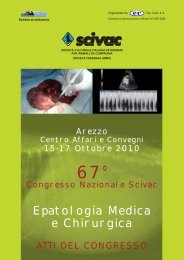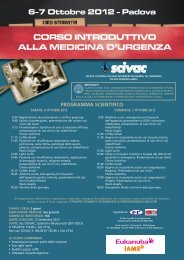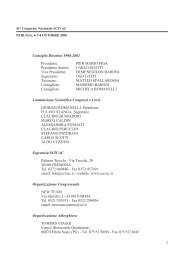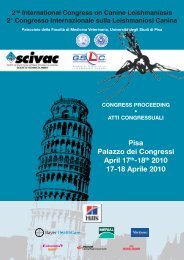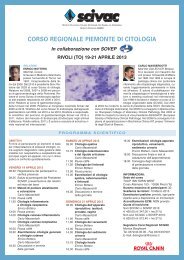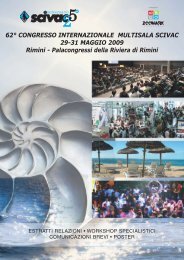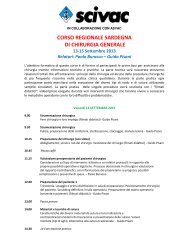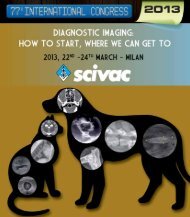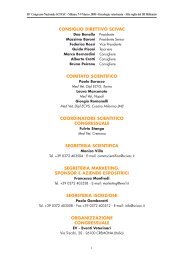68° Congresso Nazionale SCIVAC: Le domande più frequenti in ...
68° Congresso Nazionale SCIVAC: Le domande più frequenti in ...
68° Congresso Nazionale SCIVAC: Le domande più frequenti in ...
You also want an ePaper? Increase the reach of your titles
YUMPU automatically turns print PDFs into web optimized ePapers that Google loves.
<strong>68°</strong> CONGRESSO NAZIONALE <strong>SCIVAC</strong> 11-13 Marzo 2011 - Milano<br />
LE DOMANDE PIÙ FREQUENTI IN RIPRODUZIONE CANINA E FELINA<br />
Tutto quello che i vostri clienti osano spesso chiedere e a cui voi non sapete rispondere<br />
14 th EVSSAR Congress - Advances <strong>in</strong> Fel<strong>in</strong>e Reproduction - March 11 th 2011<br />
1. CRYPTORCHIDISM<br />
Cryptorchidism is def<strong>in</strong>ed as the absence of one or both testis <strong>in</strong> the scrotum<br />
after 4-8 weeks. Reta<strong>in</strong>ed testis may be located <strong>in</strong> the abdomen, <strong>in</strong> the <strong>in</strong>gu<strong>in</strong>al<br />
area (<strong>in</strong>side or outside the r<strong>in</strong>g) or ante-scrotal. The right testis is more<br />
often ectopic than the left, due to its orig<strong>in</strong>al position more cranial than the<br />
left one (caudal to kidney)<br />
Cryptorchidism is considered to be hereditary and an autosomal recessive<br />
trait. This means it is carried by both maternal and paternal l<strong>in</strong>es.<br />
Dogs with bilateral abdom<strong>in</strong>al ectopia are sterile but produce testosterone<br />
(even at higher concentration), they are sterile, but sexual behaviour is <strong>in</strong>tact.<br />
Ingu<strong>in</strong>al and ante-scrotal reta<strong>in</strong>ed testis are fertile.<br />
It is not uncommon to identify <strong>in</strong> a l<strong>in</strong>e of a dog with a reta<strong>in</strong>ed testis, report<br />
of delayed testicular descent (<strong>in</strong> position after 8 weeks of age) or reta<strong>in</strong>ed<br />
testis.<br />
Exclusion of all affected males from the breed<strong>in</strong>g programme is recommended.<br />
Some authorities recommend the exclusion of their parents and their<br />
potential offspr<strong>in</strong>g!<br />
Reta<strong>in</strong>ed testis promotes the development of testicular tumors and <strong>in</strong> a<br />
lesser extent testicular torsion (when abdom<strong>in</strong>al ectopia). 21% of dogs suffer<strong>in</strong>g<br />
from a testicular neoplasia have a reta<strong>in</strong>ed testis. About 45% of sertoli cell<br />
tumors and 30% sem<strong>in</strong>omas grow <strong>in</strong> an abdom<strong>in</strong>al reta<strong>in</strong>ed testis. Abdom<strong>in</strong>al<br />
reta<strong>in</strong>ed testits are predisposed to setoli cells tumor (the risk is 9-14 times<br />
higher than normal). Testis <strong>in</strong> <strong>in</strong>gu<strong>in</strong>al position are predisposed to sem<strong>in</strong>oma<br />
(more moderate temperature <strong>in</strong> agreement with the survival of germ cells).<br />
It is always advisable to castrate a male with reta<strong>in</strong>ed testes. The controlateral<br />
scrotal testis may be left <strong>in</strong> place and a vasectomy performed to exclude<br />
the dog from a breed<strong>in</strong>g programme.<br />
2. TESTICULAR NEOPLASIA<br />
Testicular tumors are usually benign. However 10-14% of sertoli cell tumors<br />
and 6 to 10% of sem<strong>in</strong>omas are malignant. <strong>Le</strong>iomiomas are exceptionally<br />
malignant. The tumor <strong>in</strong>filtration is most often through the epididymis, but<br />
may metastase by local <strong>in</strong>filtration of lymphatic and pamp<strong>in</strong>iform cords. Thus,<br />
metastases are ma<strong>in</strong>ly found <strong>in</strong> the local lymph nodes (iliacs lombo-aortics,<br />
rarely mesenteric), and exceptionally <strong>in</strong> the liver, spleen, lungs, mediast<strong>in</strong>um,<br />
bra<strong>in</strong>, pancreas and kidney.<br />
92



